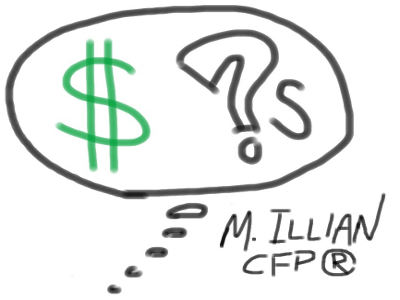
Q: This past year, we went from paying a little bit of Alternative Minimum Tax (AMT) to paying over $15,000 of this additional tax. We make approximately $300,000 in income and realized $25,000 in long-term capital gains. Is there anything we can do to avoid this penalty?
Sincerely, A. M. Teedoff
$ ?s answered by Matthew Illian, CFP®
Dear Mr. Teedoff,
What began as a mouse is now a roaring lion. The “Minimum Tax,” predecessor to the Alternative Minimum Tax (AMT), was legislated in 1969 and targeted 155 high-income households that paid no tax because they claimed a number of IRS-sanctioned tax deductions. Today, AMT affects over 4 million tax filers.
Before moving on, I want to take a moment to note the irony in all of this. Congress legislated tax loopholes for a variety of financial endeavors deemed worthy of subsidization and then legislated a penalty for those that take advantage of them. This kind of rationale only makes sense at our nation’s capital.
But that’s not all. Congress now must wrestle at the end of every fiscal year to pass a “patch” that will keep the number of AMT payers from jumping from 4 to 24 million. This is just one example of how complexity in our tax system is always trending toward absurdity.
And while some would like the rich to pay more in taxes, AMT is by no means fair. You can now fall into AMT without taking advantage of any of the unique tax deductions. Assuming a constant income, tax filers with larger families are more likely to get hit by AMT than those with smaller families. Additionally, you are more likely to pay AMT if you live in my birth state of New Jersey (high state income taxes) than if you live in my home state of Virginia (moderate state income taxes). Even better if you are from Texas or one of the six other states that charge no income taxes at all.
There are two opposing approaches to limit your AMT tax. The obvious strategy is to lower your income so you avoid this AMT bull’s-eye. The less obvious approach is to raise your income. I recognize that many will be unsettled by this approach due to an instinctual repulsion against paying any more in taxes than is absolutely necessary. After your blood pressure drops, consider that adding income can reduce your effective marginal rate from 35% down to the AMT flat-tax limit of 28% for high-income earners. Some may want to pay “only” 28% in taxes today to avoid larger tax bills in the future. Massive Roth conversions and exercising stock options are two strategies worth considering to boost income without raising your effective marginal tax.
1. More palatable approaches for reducing AMT relate to reducing your reportable income by methods that are not sterilized by the AMT calculation. Taking out a home equity loan to buy a new car will not help. However, additional pretax 401(k) contributions and charitable donations reduce both your taxable income and AMT.
2. Also check to see if your state offers tax credits. Virginia offers conservation easement tax credits that have been historically sold at 75 to 85 cents on the dollar. These credits have an added benefit for those who are subject to AMT.
3. If you don’t have a mortgage, consider financing a new house purchase. You will get the double benefit of enjoying historically low interest rates and receive deductible interest that will reduce your tax liability.
4. If you have a cafeteria plan or Flexible Savings Account (FSA) option at work, make sure you are using it to cover any eligible medical or child-care expenses that will reduce your reportable income.
5. You also want to make sure your investment advisor is using tax-efficient best practices when charging fees. Investment management fees that are recognized on Form 1040 as miscellaneous deductions get added back in the AMT calculation and lose their benefit. Make sure all eligible fees are first taken out of your qualified accounts on a pretax basis.
6. Avoid unnecessary capital gains. Realized capital gains can also increase your AMT liability, but I don’t believe total avoidance is a good strategy. Prudent investment managers understand that you should never let tax consequences be the lead driver of a robust investment plan.
If you are paying AMT, consider reviewing these strategies with your CPA or consider buying Turbo Tax and run a few different scenarios on your own. This exercise taking a few hours could save you thousands. Start preparing today for a better outcome next April.
If you have a money question that is nagging at you, please submit it using our contact page, http://www.marottaonmoney.com/contact. We try to respond to every question. If yours is chosen for MONEY QUESTIONS, we will give you a pseudonym and let you know the date the Q&A is published.